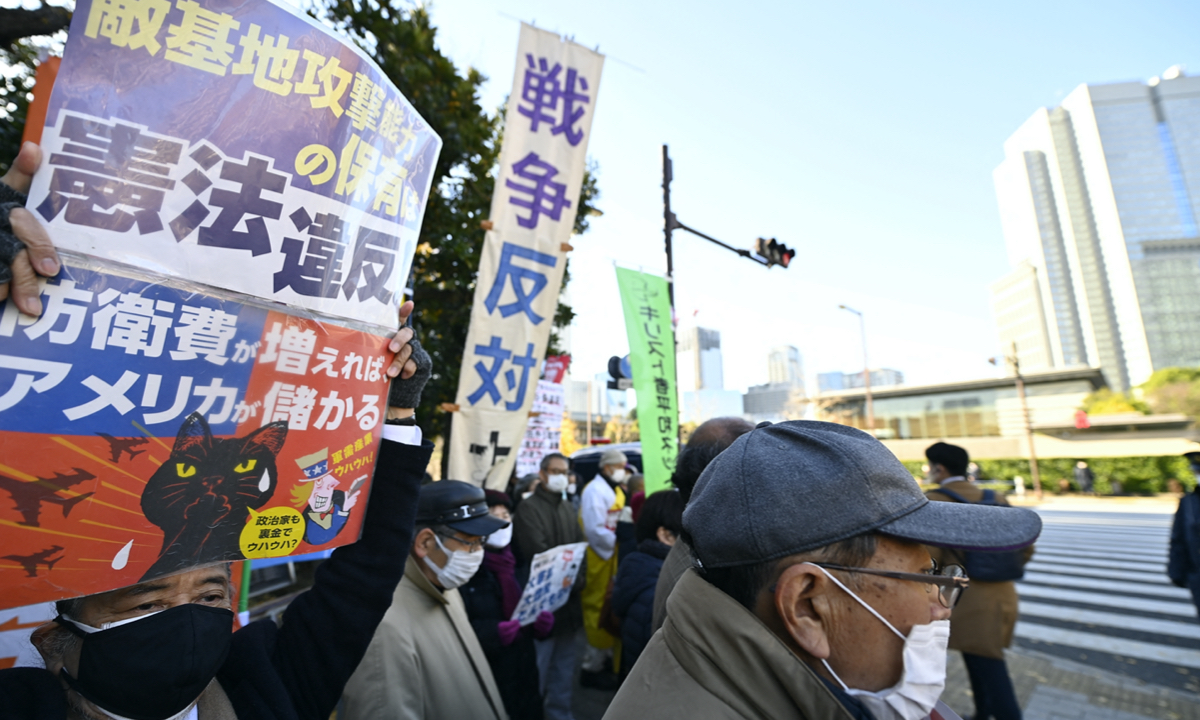
People gather outside Japanese Prime Minister Fumio Kishida's office holding placards denouncing the violation of Article 9 of the Japanese Constitution in Tokyo on December 16, 2022. They also oppose the increase in the military spending budget. Japan approved its biggest military buildup since World War II on December 16. Photo: AFP
Japan is removing its pacifist mask as it continues attempts to strengthen its military presence in the Asia-Pacific region, Chinese experts said on Wednesday, following reports that Tokyo is likely to deploy a surface-to-air missile defense unit at Japan's closest self-defense force base to China's Taiwan region.
Given the lessons from the two world wars, Japan's remilitarization should be a cause for alarm among all countries in the region, they warned.
Citing ministry spokesperson Takeshi Aoki, Japan's Jiji Press reported on Tuesday that the ministry of defense plans to deploy a surface-to-air guided missile unit on Yonaguni, a remote island in southwestern Japan that is about 110 kilometers from China's Taiwan region and 150 kilometers from China's Diaoyu Islands.
Established in 2016 on the island, Ground Self-Defense Force Camp Yonaguni is based on the island with about 200 members of self-defense forces stationed there.
According to sources reached by Jiji Press, the planned deployment, which also means the expansion of the Camp Yonaguni, is intended to "strengthen the defense of the Ryukyu Islands," including Yonaguni, in the face of China's "military pressure" they hyped.
Liu Jiangyong, vice dean of the Institute of Modern International Relations at Tsinghua University, told the Global Times on Wednesday that deploying a missile defense unit at the Ground Self-Defense Force camp closest to Taiwan island is a specific step from Tokyo to implement their new national security guidelines.
Japan on December 16 approved three documents - the National Security Strategy, the National Defense Program Guidelines, and the Mid-Term Defense Program - in one of
the country's largest defense shake-ups since World War II. The documents involve Japan's biggest military post-war build-up plan, with $320 billion to buy missiles "capable of striking China," its "greatest strategic challenge."
Japan uses Camp Yonaguni as a stronghold and front for its military strategy. By strengthening its military presence in the region, it tries to perform a deterrence to the People's Liberation Army by sending a signal that Tokyo is capable of intervening in the Taiwan Straits and the Diaoyu Islands, so as to better comfort Taiwan secessionists, Liu said.
On December 11, policy chief of Japan's ruling Liberal Democratic Party (LDP) Koichi Hagiuda said Japan needs to increase its military spending when meeting with secessionist leader Tsai Ing-wen in Taiwan on December 11.
Chinese military experts Song Zhongping told the Global Times that given that Yonaguni is only a 28.9-square-kilometer island, it is more likely that Japan intends to use the surface-to-air guided missile unit to safeguard its intelligence and monitoring capability.
Yonaguni is Japan's closest land to Taiwan island and to key military bases along the Chinese mainland's southeastern coast. Japan has been deploying monitoring stations on Yonaguni to snoop on activities of both the mainland and Taiwan.
Therefore, Chinese experts said not only Yonaguni, but also the entire Ryukyu Islands is expected to be at the forefront of Japan's military deterrence against China in the next five years, with the ability to deploy weapons to strike important military installations within enemy territory.
This means that in the future, Japan may completely get rid of its post-war pacifist image that was of great importance to its economic development, to become a country that poses a threat to its neighbors, develops its military industry, and is likely to use force abroad, Liu warned.
This will be the biggest change in East Asia since World War II and will bring great danger to the whole Asia-Pacific region, Liu added.




